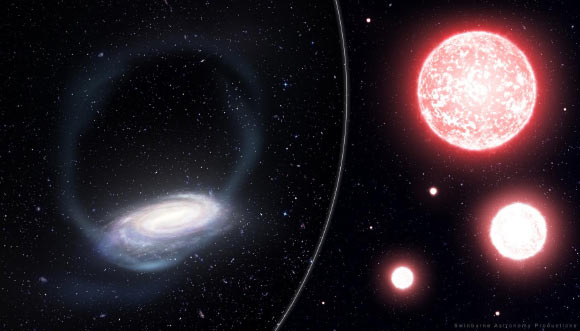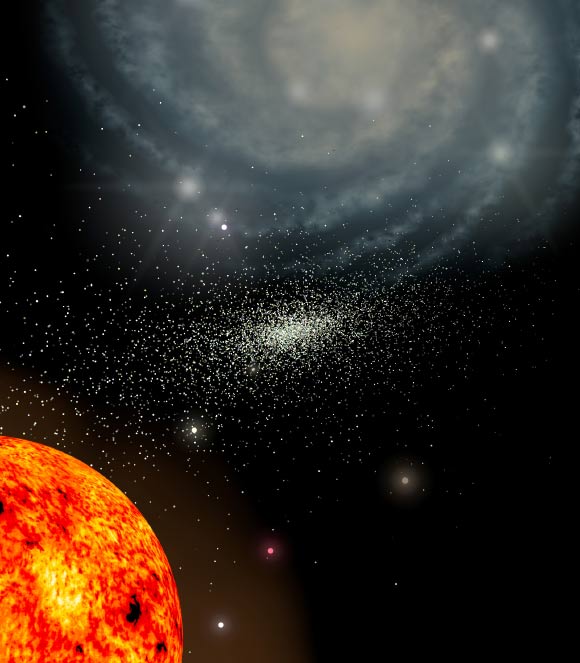The Phoenix stellar stream, a thin over-density of stars in the halo of our Milky Way Galaxy originally identified by the Dark Energy Survey, is composed of the debris of a very ancient globular cluster that was torn apart by the Milky Way’s gravity 2 billion years ago, according to new research led by the University of Sydney.

An artist’s impression of the thin stream of stars torn from the Phoenix globular cluster, wrapping around the Milky Way (left). Wan et al targeted bright red giant stars (right) to measure the chemical composition of the disrupted Phoenix globular cluster. Image credit: James Josephides, Swinburne Astronomy Productions / S5 Collaboration.
Globular clusters are agglomerations of very ancient stars, held together by their mutual gravitational attraction in a spherical shape about 100-200 light-years across.
They contain hundreds of thousands or perhaps a million stars. The large mass in the rich stellar center of a cluster pulls the stars inward to form a ball of stars. The word globulus, from which these objects take their name, is Latin for small sphere.
They are among the oldest bound stellar structures observed in the Universe and are relics of the first epochs of galaxy formation.
It is thought that every galaxy has a population of globular clusters. Some, like our Milky Way Galaxy, have a few hundred, while elliptical galaxies can have several thousand globular clusters.
The parent cluster of the Phoenix stellar stream had a lifecycle that was very different from the globular clusters we see today.
“The globular cluster remnants that make up the Phoenix stream were disrupted many billion years ago, but luckily retain the memory of its formation in the very early Universe, which we can read from the chemical composition of its stars,” said Dr. Ting Li, an astronomer at the Observatories of the Carnegie Institution for Science, Princeton University, Fermi National Accelerator Laboratory and the Kavli Institute for Cosmological Physics at the University of Chicago.

An artist’s representation of the Phoenix stellar stream. Image credit: Geraint F. Lewis / S5 Collaboration.
Using the Anglo-Australian Telescope, the astronomers measured the metallicity — the abundance of elements heavier than hydrogen and helium — of bright red giant star in the Phoenix stellar stream.
“We were really surprised to find that the Phoenix stream has a very low metallicity, making it distinctly different to all of the other globular clusters in the Galaxy,” said Zhen Wan, a Ph.D. student at the University of Sydney.
Because other known globular clusters are enriched by the presence of heavy elements forged by stellar earlier generations, it was theorized that there was a minimum abundance of heavier elements required for a globular cluster to form.
But the Phoenix stream progenitor is well below this predicted minimum metallicity, posing a significant problem for previous ideas about how globular clusters are born.
“This stream comes from a cluster that, by our understanding, shouldn’t have existed,” said Dr. Daniel Zucker, an astronomer at Macquarie University.
“One possible explanation is that the Phoenix stream represents the last of its kind, the remnant of a population of globular clusters that was born in radically different environments to those we see today,” Dr. Li said.
While potentially numerous in the past, this population of globular clusters was steadily depleted by the gravitational forces of the Galaxy, which tore them to pieces, absorbing their stars into the main body of the galactic system.
This means that the stream is a relatively temporary phenomenon, which will dissipate in time.
“We found the remains of this cluster before it faded forever into the Galaxy’s halo,” Wan said.
As yet, there is no clear explanation for the origins of the Phoenix stream progenitor cluster and where it sits in the evolution of galaxies remains unclear.
“There is plenty of theoretical work left to do. There are now many new questions for us to explore about how galaxies and globular clusters form, which is incredibly exciting,” said Professor Geraint Lewis, an astronomer at the University of Sydney.
The discovery is reported in a paper in the journal Nature.
_____
Z. Wan et al. 2020. The tidal remnant of an unusually metal-poor globular cluster. Nature 583, 768-770; doi: 10.1038/s41586-020-2483-6







